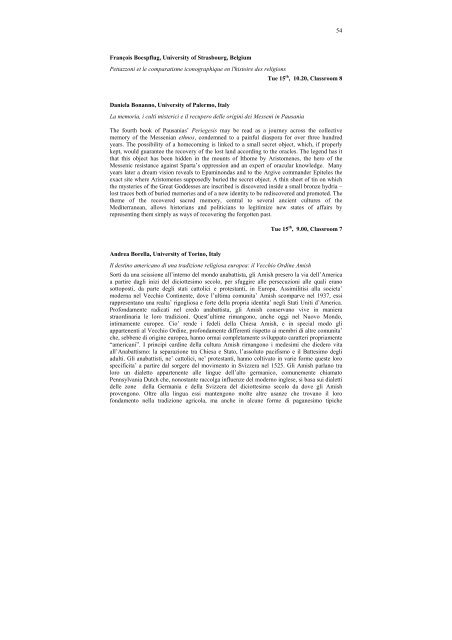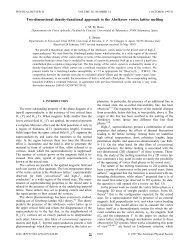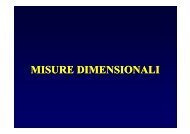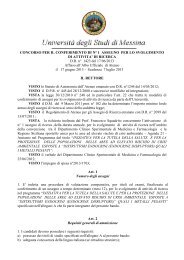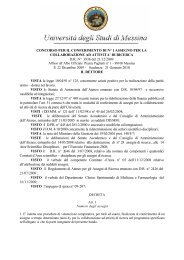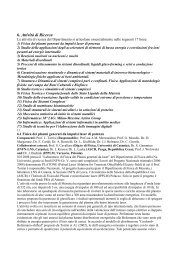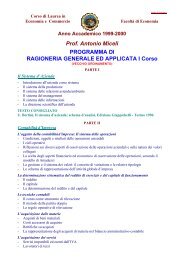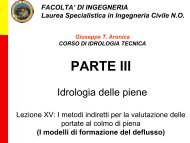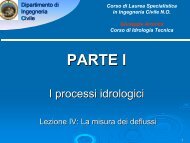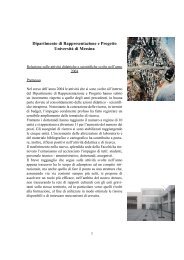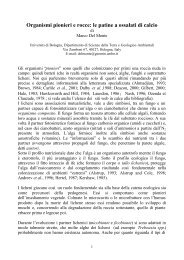PROGRAMME AND ABSTRACTS - Università degli Studi di Messina
PROGRAMME AND ABSTRACTS - Università degli Studi di Messina
PROGRAMME AND ABSTRACTS - Università degli Studi di Messina
Create successful ePaper yourself
Turn your PDF publications into a flip-book with our unique Google optimized e-Paper software.
François Boespflug, University of Strasbourg, Belgium<br />
Pettazzoni et le comparatisme iconographique en l'histoire des religions<br />
Daniela Bonanno, University of Palermo, Italy<br />
La memoria, i culti misterici e il recupero delle origini dei Messeni in Pausania<br />
54<br />
Tue 15 th , 10.20, Classroom 8<br />
The fourth book of Pausanias’ Periegesis may be read as a journey across the collective<br />
memory of the Messenian ethnos, condemned to a painful <strong>di</strong>aspora for over three hundred<br />
years. The possibility of a homecoming is linked to a small secret object, which, if properly<br />
kept, would guarantee the recovery of the lost land accor<strong>di</strong>ng to the oracles. The legend has it<br />
that this object has been hidden in the mounts of Ithome by Aristomenes, the hero of the<br />
Messenic resistance against Sparta’s oppression and an expert of oracular knowledge. Many<br />
years later a dream vision reveals to Epaminondas and to the Argive commander Epiteles the<br />
exact site where Aristomenes supposedly buried the secret object. A thin sheet of tin on which<br />
the mysteries of the Great Goddesses are inscribed is <strong>di</strong>scovered inside a small bronze hydria –<br />
lost traces both of buried memories and of a new identity to be re<strong>di</strong>scovered and promoted. The<br />
theme of the recovered sacred memory, central to several ancient cultures of the<br />
Me<strong>di</strong>terranean, allows historians and politicians to legitimize new states of affairs by<br />
representing them simply as ways of recovering the forgotten past.<br />
Andrea Borella, University of Torino, Italy<br />
Tue 15 th , 9.00, Classroom 7<br />
Il destino americano <strong>di</strong> una tra<strong>di</strong>zione religiosa europea: il Vecchio Or<strong>di</strong>ne Amish<br />
Sorti da una scissione all’interno del mondo anabattista, gli Amish presero la via dell’America<br />
a partire dagli inizi del <strong>di</strong>ciottesimo secolo, per sfuggire alle persecuzioni alle quali erano<br />
sottoposti, da parte <strong>degli</strong> stati cattolici e protestanti, in Europa. Assimilitisi alla societa’<br />
moderna nel Vecchio Continente, dove l’ultima comunita’ Amish scomparve nel 1937, essi<br />
rappresentano una realta’ rigogliosa e forte della propria identita’ negli Stati Uniti d’America.<br />
Profondamente ra<strong>di</strong>cati nel credo anabattista, gli Amish conservano vive in maniera<br />
straor<strong>di</strong>naria le loro tra<strong>di</strong>zioni. Quest’ultime rimangono, anche oggi nel Nuovo Mondo,<br />
intimamente europee. Cio’ rende i fedeli della Chiesa Amish, e in special modo gli<br />
appartenenti al Vecchio Or<strong>di</strong>ne, profondamente <strong>di</strong>fferenti rispetto ai membri <strong>di</strong> altre comunita’<br />
che, sebbene <strong>di</strong> origine europea, hanno ormai completamente sviluppato caratteri propriamente<br />
“americani”. I principi car<strong>di</strong>ne della cultura Amish rimangono i medesimi che <strong>di</strong>edero vita<br />
all’Anabattismo: la separazione tra Chiesa e Stato, l’assoluto pacifismo e il Battesimo <strong>degli</strong><br />
adulti. Gli anabattisti, ne’ cattolici, ne’ protestanti, hanno coltivato in varie forme queste loro<br />
specificita’ a partire dal sorgere del movimento in Svizzera nel 1525. Gli Amish parlano tra<br />
loro un <strong>di</strong>aletto appartenente alle lingue dell’alto germanico, comunemente chiamato<br />
Pennsylvania Dutch che, nonostante raccolga influenze del moderno inglese, si basa sui <strong>di</strong>aletti<br />
delle zone della Germania e della Svizzera del <strong>di</strong>ciottesimo secolo da dove gli Amish<br />
provengono. Oltre alla lingua essi mantengono molte altre usanze che trovano il loro<br />
fondamento nella tra<strong>di</strong>zione agricola, ma anche in alcune forme <strong>di</strong> paganesimo tipiche


